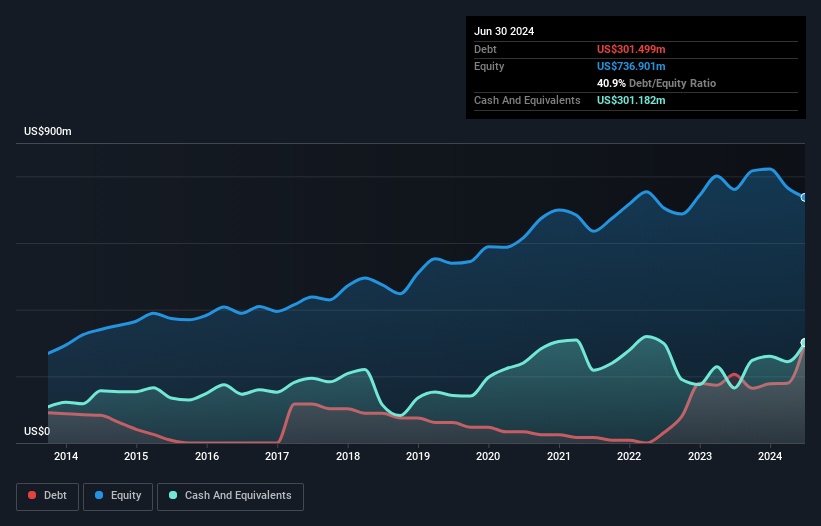- United States
- /
- Professional Services
- /
- NYSE:WNS
These 4 Measures Indicate That WNS (Holdings) (NYSE:WNS) Is Using Debt Reasonably Well
Legendary fund manager Li Lu (who Charlie Munger backed) once said, 'The biggest investment risk is not the volatility of prices, but whether you will suffer a permanent loss of capital.' So it might be obvious that you need to consider debt, when you think about how risky any given stock is, because too much debt can sink a company. We can see that WNS (Holdings) Limited (NYSE:WNS) does use debt in its business. But should shareholders be worried about its use of debt?
What Risk Does Debt Bring?
Debt assists a business until the business has trouble paying it off, either with new capital or with free cash flow. Part and parcel of capitalism is the process of 'creative destruction' where failed businesses are mercilessly liquidated by their bankers. However, a more usual (but still expensive) situation is where a company must dilute shareholders at a cheap share price simply to get debt under control. Of course, the upside of debt is that it often represents cheap capital, especially when it replaces dilution in a company with the ability to reinvest at high rates of return. When we think about a company's use of debt, we first look at cash and debt together.
See our latest analysis for WNS (Holdings)
How Much Debt Does WNS (Holdings) Carry?
You can click the graphic below for the historical numbers, but it shows that as of June 2024 WNS (Holdings) had US$301.5m of debt, an increase on US$206.2m, over one year. On the flip side, it has US$301.2m in cash leading to net debt of about US$317.0k.

How Strong Is WNS (Holdings)'s Balance Sheet?
We can see from the most recent balance sheet that WNS (Holdings) had liabilities of US$371.2m falling due within a year, and liabilities of US$389.5m due beyond that. Offsetting these obligations, it had cash of US$301.2m as well as receivables valued at US$250.5m due within 12 months. So its liabilities total US$209.0m more than the combination of its cash and short-term receivables.
Given WNS (Holdings) has a market capitalization of US$2.59b, it's hard to believe these liabilities pose much threat. Having said that, it's clear that we should continue to monitor its balance sheet, lest it change for the worse. Carrying virtually no net debt, WNS (Holdings) has a very light debt load indeed.
In order to size up a company's debt relative to its earnings, we calculate its net debt divided by its earnings before interest, tax, depreciation, and amortization (EBITDA) and its earnings before interest and tax (EBIT) divided by its interest expense (its interest cover). This way, we consider both the absolute quantum of the debt, as well as the interest rates paid on it.
WNS (Holdings)'s net debt to EBITDA ratio is very low, at 0.0013, suggesting the debt is only trivial. Although with EBIT only covering interest expenses 6.9 times over, the company is truly paying for borrowing. Fortunately, WNS (Holdings) grew its EBIT by 8.8% in the last year, making that debt load look even more manageable. When analysing debt levels, the balance sheet is the obvious place to start. But ultimately the future profitability of the business will decide if WNS (Holdings) can strengthen its balance sheet over time. So if you want to see what the professionals think, you might find this free report on analyst profit forecasts to be interesting.
Finally, a company can only pay off debt with cold hard cash, not accounting profits. So we always check how much of that EBIT is translated into free cash flow. Over the last three years, WNS (Holdings) recorded free cash flow worth a fulsome 92% of its EBIT, which is stronger than we'd usually expect. That positions it well to pay down debt if desirable to do so.
Our View
Happily, WNS (Holdings)'s impressive conversion of EBIT to free cash flow implies it has the upper hand on its debt. And that's just the beginning of the good news since its net debt to EBITDA is also very heartening. Looking at the bigger picture, we think WNS (Holdings)'s use of debt seems quite reasonable and we're not concerned about it. After all, sensible leverage can boost returns on equity. Over time, share prices tend to follow earnings per share, so if you're interested in WNS (Holdings), you may well want to click here to check an interactive graph of its earnings per share history.
At the end of the day, it's often better to focus on companies that are free from net debt. You can access our special list of such companies (all with a track record of profit growth). It's free.
Valuation is complex, but we're here to simplify it.
Discover if WNS (Holdings) might be undervalued or overvalued with our detailed analysis, featuring fair value estimates, potential risks, dividends, insider trades, and its financial condition.
Access Free AnalysisHave feedback on this article? Concerned about the content? Get in touch with us directly. Alternatively, email editorial-team (at) simplywallst.com.
This article by Simply Wall St is general in nature. We provide commentary based on historical data and analyst forecasts only using an unbiased methodology and our articles are not intended to be financial advice. It does not constitute a recommendation to buy or sell any stock, and does not take account of your objectives, or your financial situation. We aim to bring you long-term focused analysis driven by fundamental data. Note that our analysis may not factor in the latest price-sensitive company announcements or qualitative material. Simply Wall St has no position in any stocks mentioned.
About NYSE:WNS
WNS (Holdings)
A business process management (BPM) company, provides data, voice, analytical, and business transformation services worldwide.
Solid track record with excellent balance sheet.
Similar Companies
Market Insights
Community Narratives





